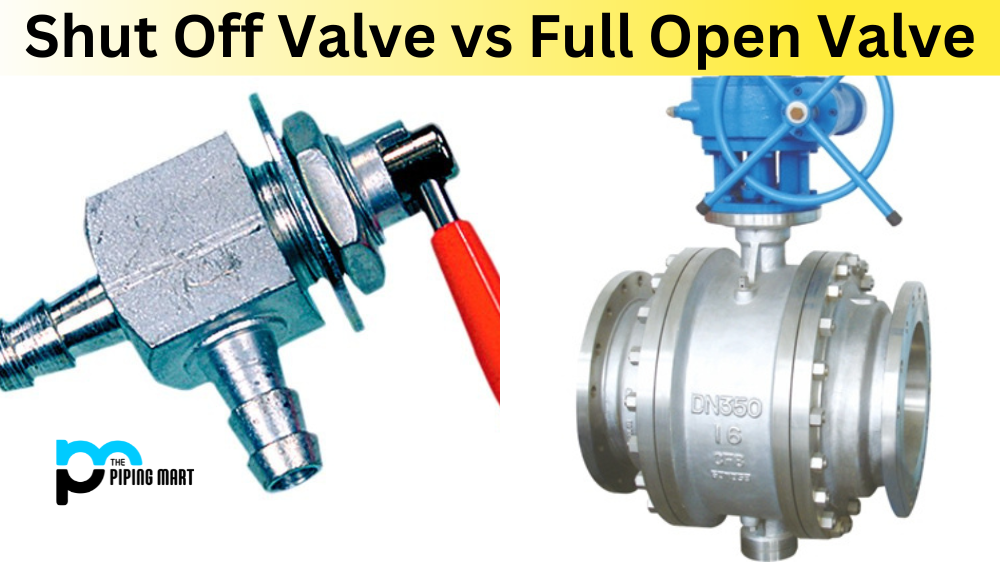As a homeowner or property manager, one of the most important things to understand is how your plumbing system works. And one key component of a plumbing system is the valve. A valve controls the flow of water or other fluids in a system. But when it comes to valves, not all are created equal. In this blog post, we’ll discuss the difference between Shut Off Valve and Full Open Valve and what situations they are best used in.
What is a Shut-Off Valve?
A shut-off valve is designed to stop water flow in a plumbing system. It is typically located near the fixture or appliance it serves. This type of valve is often used in emergencies, such as when a pipe bursts or an appliance leaks. Shut-off valves are also commonly used to isolate specific areas of a plumbing system for maintenance or repair. They are generally made of brass or stainless steel and can be operated by a quarter-turn handle or a multi-turn knob.
What is a Complete Open Valve?
A complete open or ball valve allows full flow through a plumbing system. This type of valve is commonly used for main water supply lines or irrigation systems. Available valves are a good choice when a high water flow is required, such as filling a pool or watering a large garden. They are made of brass or PVC and can be operated by a lever, which rotates a ball inside the valve body.
Difference Between Shut Off Valve and Full Open Valve
Use a Shut-Off Valve?
If you have a sudden plumbing emergency, such as a burst pipe, you must stop the water flow immediately to prevent further damage. In such cases, shut-off valves are the best choice for quickly and easily isolating the affected area. Shut-off valves are also useful for routine maintenance or repairs around the home or office. They allow you to work on one area of the plumbing system without shutting off the water supply to the entire building.
Use a complete Open Valve?
Full open valves are ideal for large volumes of water needing to be moved quickly and efficiently. For example, if you have a large garden requiring regular watering, a complete open valve will allow you to quickly fill a watering can or hose bucket. Full available valves are also commonly used in industrial settings, such as factories or manufacturing plants, where a high volume of water or other fluids is required.
Which Valve is Best for Your Needs?
The choice between shut-off valves and full-open valves depends on your specific needs. For residential applications, most shut-off valves will suffice. However, if you own a large property or run an irrigation system, investing in full-open valves may be worthwhile to ensure efficient water flow. It’s also worth noting that full-open valves are generally more expensive than shut-off valves due to their design and materials.
Other Differences
- A shut-off valve is a valve that is used to stop the flow of water or other fluid.
- A complete open valve is a valve that allows the full flow of water or other fluid.
- Shut-off valves are typically used in residential and commercial applications, while full-open valves are used in industrial applications.
- Shut-off valves are usually installed at the end of a pipe or other water supply line, while full-open valves are usually installed in the middle of a pipe or water supply line.
- Shut-off valves are typically used to control water flow to a specific area. In contrast, full-open valves generally allow the maximum water flow through a pipe or water supply line.
- Shut-off valves can be manually or automatically operated, while full-open valves are usually automatically operated.
- Shut-off valves are available in various sizes and materials, while full-open valves are typically only available in larger and heavier-duty materials.
- Shut-off valves typically cost more than full-open valves
Conclusion
In summary, the difference between shut-off and full-open valves lies in their function – one is designed to completely stop water flow, while the other is designed to allow maximum flow. The choice between the two depends on your specific needs and the nature of your plumbing system. This blog post has helped you understand the differences between the two types of valves and when to use them. Always consult a qualified plumber if you’re unsure which valve is best for your needs.




